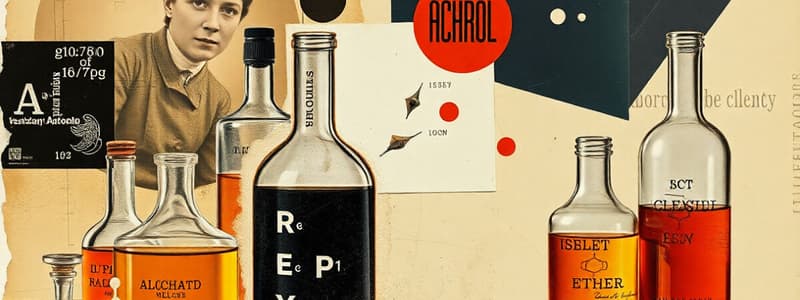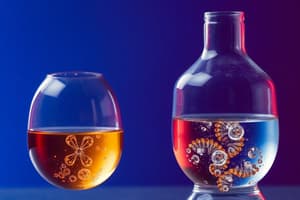Podcast
Questions and Answers
What are the primary types of alcohol mentioned in the content?
What are the primary types of alcohol mentioned in the content?
Monohydric alcohol and phenol.
What is the focus of electrophilic substitution reactions related to phenols?
What is the focus of electrophilic substitution reactions related to phenols?
Electrophilic substitution reactions focus on altering the phenolic structure through the addition of electrophiles.
How are ethers categorized according to the content?
How are ethers categorized according to the content?
Ethers are categorized as a type of alcohol.
Name one method of preparing ether as suggested in the content.
Name one method of preparing ether as suggested in the content.
What does the IUPAC nomenclature refer to in the context provided?
What does the IUPAC nomenclature refer to in the context provided?
Identify one oxidation reaction mentioned that involves phenols.
Identify one oxidation reaction mentioned that involves phenols.
What is the significance of Lucas test in relation to alcohols?
What is the significance of Lucas test in relation to alcohols?
What is the primary reaction type associated with benzene derivatives in the context?
What is the primary reaction type associated with benzene derivatives in the context?
Flashcards
Phenol
Phenol
A type of organic compound that contains a hydroxyl (-OH) group directly bonded to a benzene ring.
Alcohol
Alcohol
A type of organic compound characterized by the presence of a hydroxyl (-OH) group attached to a saturated carbon atom.
Ether
Ether
A type of organic compound where an oxygen atom links two alkyl or aryl groups.
Substitution Reaction
Substitution Reaction
Signup and view all the flashcards
Electrophilic Aromatic Substitution
Electrophilic Aromatic Substitution
Signup and view all the flashcards
Addition Reaction
Addition Reaction
Signup and view all the flashcards
Oxidation Reaction
Oxidation Reaction
Signup and view all the flashcards
Study Notes
Alcohol, Phenol & Ether
- Class XII Board Exam Notes
- Verified by top faculties and CBSE science toppers
- Target 100
- Previous year questions
- Updated syllabus
Flow Chart
- Preparation: Alcohol, Phenol
- Physical Properties: Boiling point, Solubility
- Reaction of Alcohol: Electrophilic substitution reactions (Kolbe's, Reimer-Tiemann), Oxidation
- Reaction of Phenol: Electrophilic substitution reactions (Kolbe's, Reimer-Tiemann), Oxidation
- Reaction of Ether: Preparation of ethers, ESR of Anisole, Halogenation, Friedel Crafts reaction, conversions, Lucas test
- Types of Monohydric Alcohols: IUPAC Nomenclature
- Alcohol, Phenol, and Ether: Various reactions
Alcohols, Phenols, and Ethers
- Monohydric Alcohols: Compounds containing C-sp³-OH bonds
- Primary Alcohol: R-CH₂-OH
- Secondary Alcohol: R-CH(OH)-R'
- Tertiary Alcohol: R-C(OH)(R')(R")
- Benzylic Alcohols: Carbon next to benzene
- Allylic Alcohols: Carbon next to double bond
- IUPAC Nomenclature: Longest carbon chain, numbered nearest to hydroxyl (-OH). Examples: Methanol (methyl alcohol), 2-Methylpropan-2-ol (tert-Butyl alcohol), Propan-2-ol (Isopropyl alcohol)
- Benzylic Alcohols: Group of compounds with -OH group attached to a carbon adjacent to an aromatic ring
- Allylic Alcohols: group of compounds with -OH group attached to a carbon adjacent to a double bond
IUPAC Nomenclature of Phenols
- Phenol: Benzene-1-ol
- Cresol: Methylphenol (o-, m-, or p-)
- Catechol: Benzene-1, 2-diol
- Resorcinol: Benzene-1,3-diol
- Quinol (Hydroquinone): Benzene-1,4-diol
- Picric Acid: 2, 4, 6-Trinitrophenol
- 2,5-Dinitrophenol: A specific type of phenol
IUPAC Nomenclature of Ethers
- Common name: Alkyl groups separately, then "ether"
- Examples: Dimethyl ether, Methyl n-propyl ether, Methoxy benzene (anisole)
Preparation of Alcohols
- Acid-catalyzed hydration: From alkenes, using H₂O and H⁺
- Hydroboration-oxidation method: From alkenes, using BH₃ and H₂O₂
Preparation of Phenol
- From haloarenes
- From benzenesulfonic acid
- From diazonium salts
- Cumene hydroperoxide method
Preparation of Ethers
- By dehydration of alcohols: CH₃CH₂OH → CH₃CH₂OCH₂CH₃
- Williamson Synthesis: Alkyl halide + Sodium alkoxide → ether
Reactions of Alcohol, Phenol, and Ether
- Electrophilic Aromatic Substitution
- Oxidation
- Halogenation
- Friedel Crafts Reaction
- Nitration
- Kolbe's Reaction
- Reimer-Tiemann Reaction
- Phenol with Zn dust
- Phenol to toluene
Boiling Point and Solubility
- Boiling points generally increase with the number of carbon atoms
- Alcohols and phenols have higher boiling points compared to hydrocarbons due to hydrogen bonding
- Solubility in water: due to hydrogen bonding ability
- Solubility decreases as the alkyl/aryl groups increase in size
Studying That Suits You
Use AI to generate personalized quizzes and flashcards to suit your learning preferences.




